


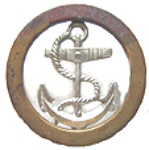
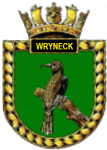
No.C/JX 150658, Telegraphist, Douglas Percy ADAMS
Aged 20

|
Douglas Percy ADAMS was born on 18th February 1921 at 47 Haydon Road, Wimbledon (Kingston Q2-1921 2A:755) son of Hilda ADAMS (born 1900 Brandon). His father is unknown. The birth certificate gives his mother as Domestic Housemaid, of The Lodge, Kingsway, Mildenhall, living at 47 Haydon Road, Wimbledon. Apparently he was brought up by his grandparents. It may be his mother was the Hilda F Adams who married Alfred H GRUBB in Wimbledon in 1929 In the 1939 register his grandparents were at 179 Thetford Road, Mildenhall, grandfather Thomas W ADAMS [10-5-1899] a lorry driver; grandmother Polly (register mistakenly has Lottie) [16-10-1899]. Also there, (relationship not recorded) were Ruby M Adams [6-2-1927] (later DENT), Thomas W Adams [8-4-1929] and Robert J Adams [21-10-1938]. There are two closed records. |

|
HMS Wryneck was ordered on 16 December 1916 from Palmers Shipbuilding and Iron Company at Jarrow in the 10th Order of the 1916–17 Programme. She was laid down in
April 1917, launched on 13 May 1918, and completed on the last day of the war, 11 November 1918. Wryneck was put into Reserve during the economic crisis of the 1930s and laid up in Gibraltar. In 1938 she was selected for WAIR conversion to a fast escort ship at Gibraltar Dockyard. The work began in September 1939 and was not completed until March 1940. In April 1940, after sea trials, Wryneck was recommissioned for service with the new pennant number L04, and assigned to convoy defence duty based at Alexandria. In December she was detached to support military operations against the Italian army in Egypt. In January 1941 she resumed convoy defence duties, and in March formed part of the escort of military convoys taking British and Commonwealth troops to Greece as part of "Operation Lustre". In April, with the fall of Greece, Wryneck returned to help the evacuation of Allied troops. At 4am on 27th April 1941, the Dutch liner SS Slamat, with 211 crew and 500 Allied troops, which included Horace, Edward and other soldiers of the Royal Army Service Corps, left Nauplia Harbour. They were too late to escape an attack by German Stukas of Jagdgeschwader 77. The Slamat sank with the loss of 193 men. Of the troops on board, around 700 were rescued by the destroyers HMS Diamond and HMS Wryneck, both of which were later bombed and sunk (36.30 N 23.34 E), drowning most of the survivors of the Slamat. In all, there was just one officer, 41 seamen and 8 soldiers saved from this triple disaster, leaving a total death toll of 843 men. At about 13:15, an air attack by German Messerschmitt Bf 109 fighters and Junkers Ju 88 bombers[5] sank HMS Diamnd and HMS Wryneck within minutes. Wryneck launched her whaler, and each destroyer launched her three Carley floats. Survivors in the whaler set off east past Cape Maleas, towing two Carley floats and their occupants . In the evening the wind increased, causing the floats to strike the boat, reluctantly they were cast adrift. After 1900 hrs on 27 April the Vice Admiral, Light Forces, Henry Pridham-Wippell, became concerned that Diamond had not returned to Souda Bay and was not answering radio signals. Wryneck had been ordered to keep radio silence so no attempt was made to radio her. Pridham-Wippell sent the destroyer HMS Griffin to the position where Slamat had been lost. She found 14 survivors in two Carley floats that night, more floats and another four survivors in the morning, and took the survivors to Crete. The last living survivor from Slamat, Royal Army Service Corps veteran George Dexter, states that after Wryneck was sunk he and three other men were rescued by the cruiser HMS Orion. |

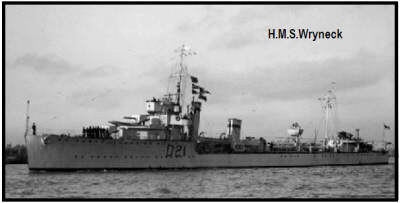
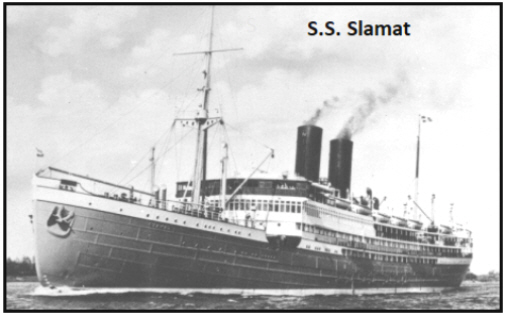
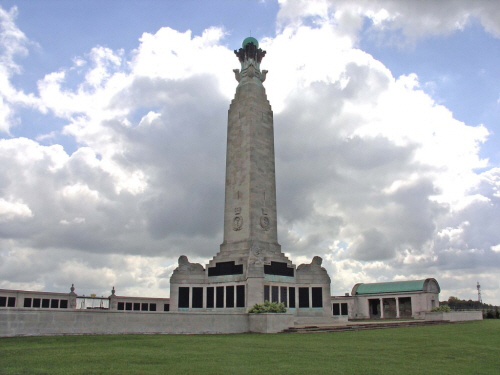
photo: Commonwealth War Graves Commission
click here to go to the Commonwealth War Graves Commission website for full cemetery/memorial details